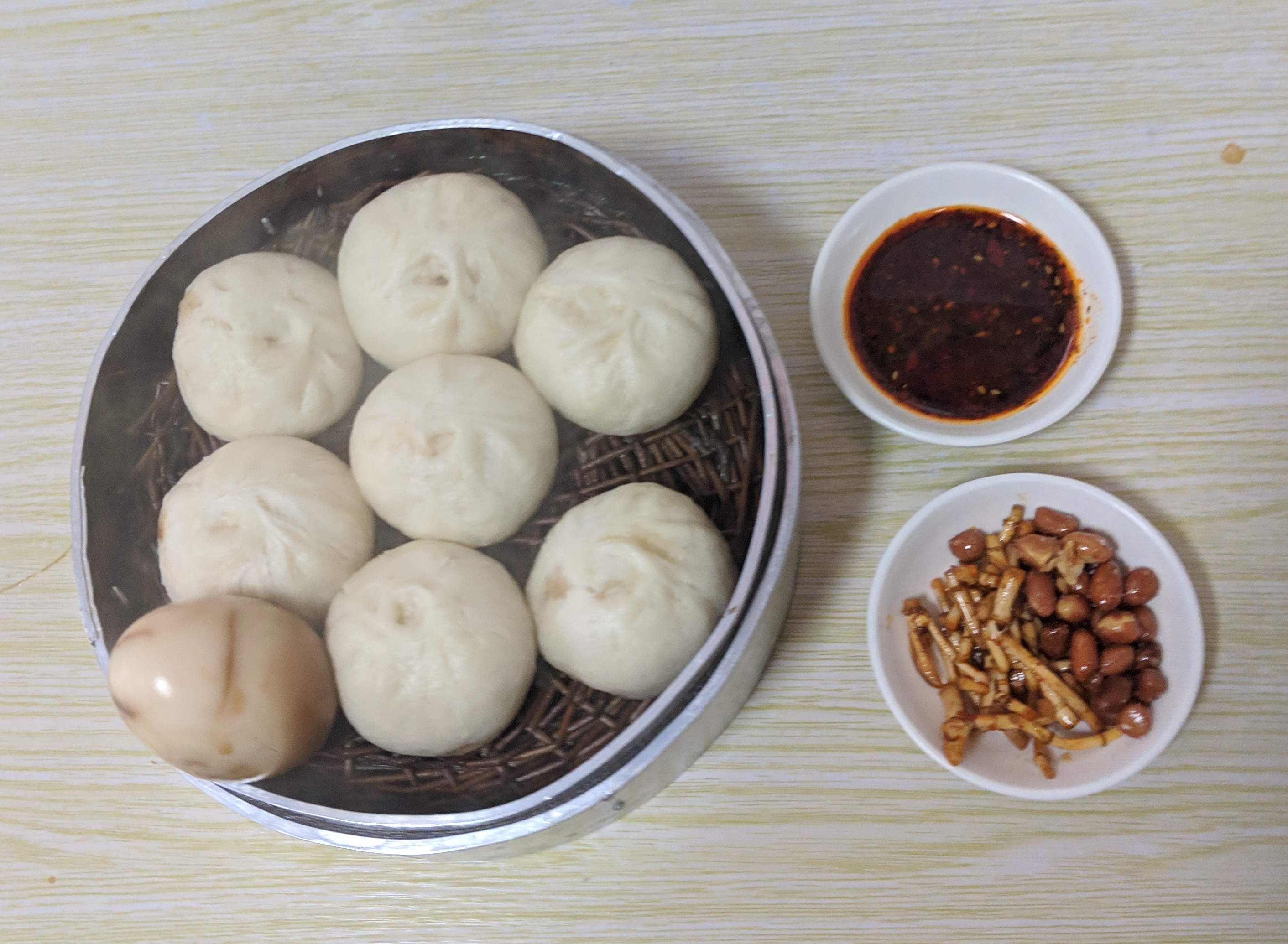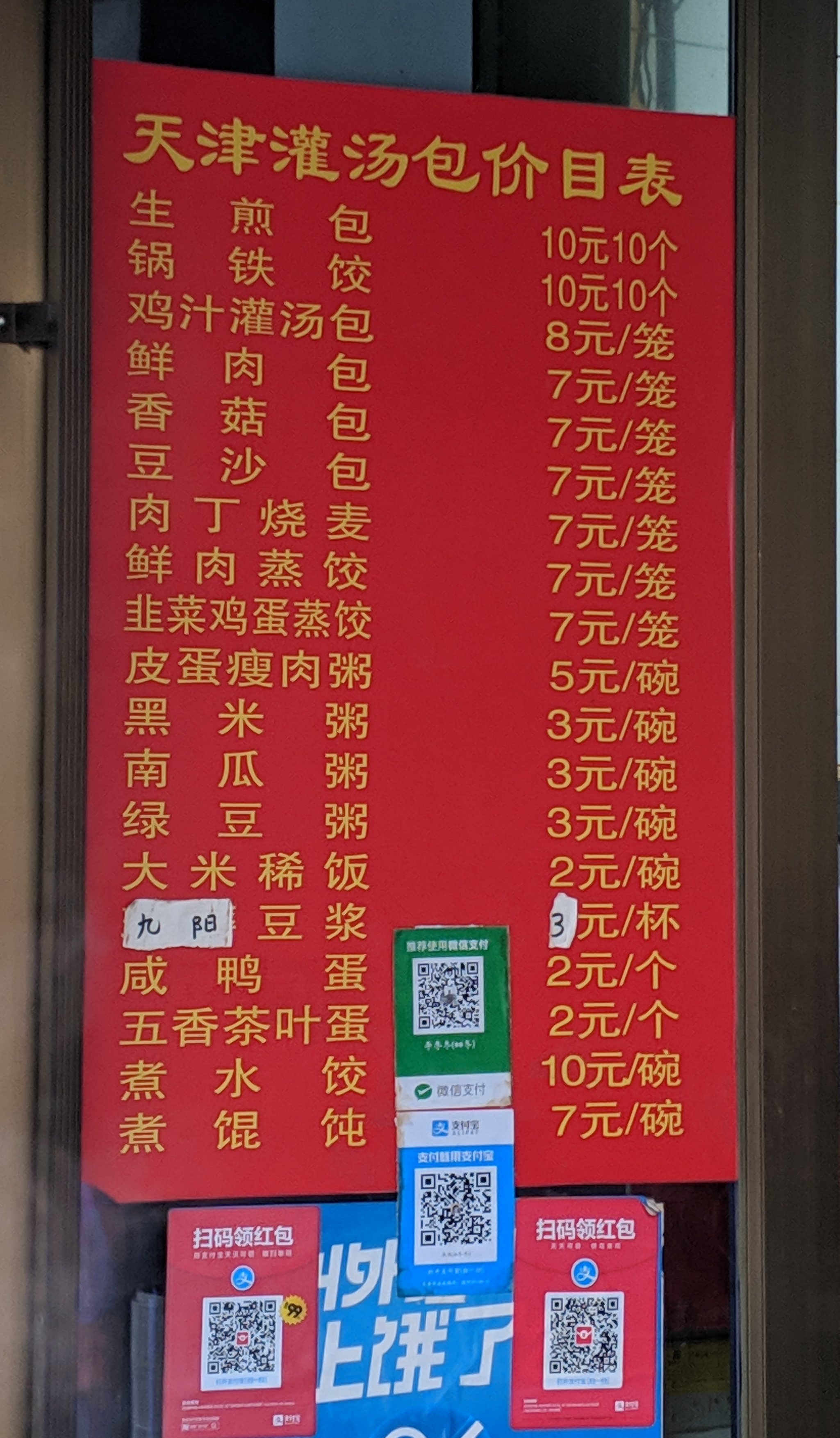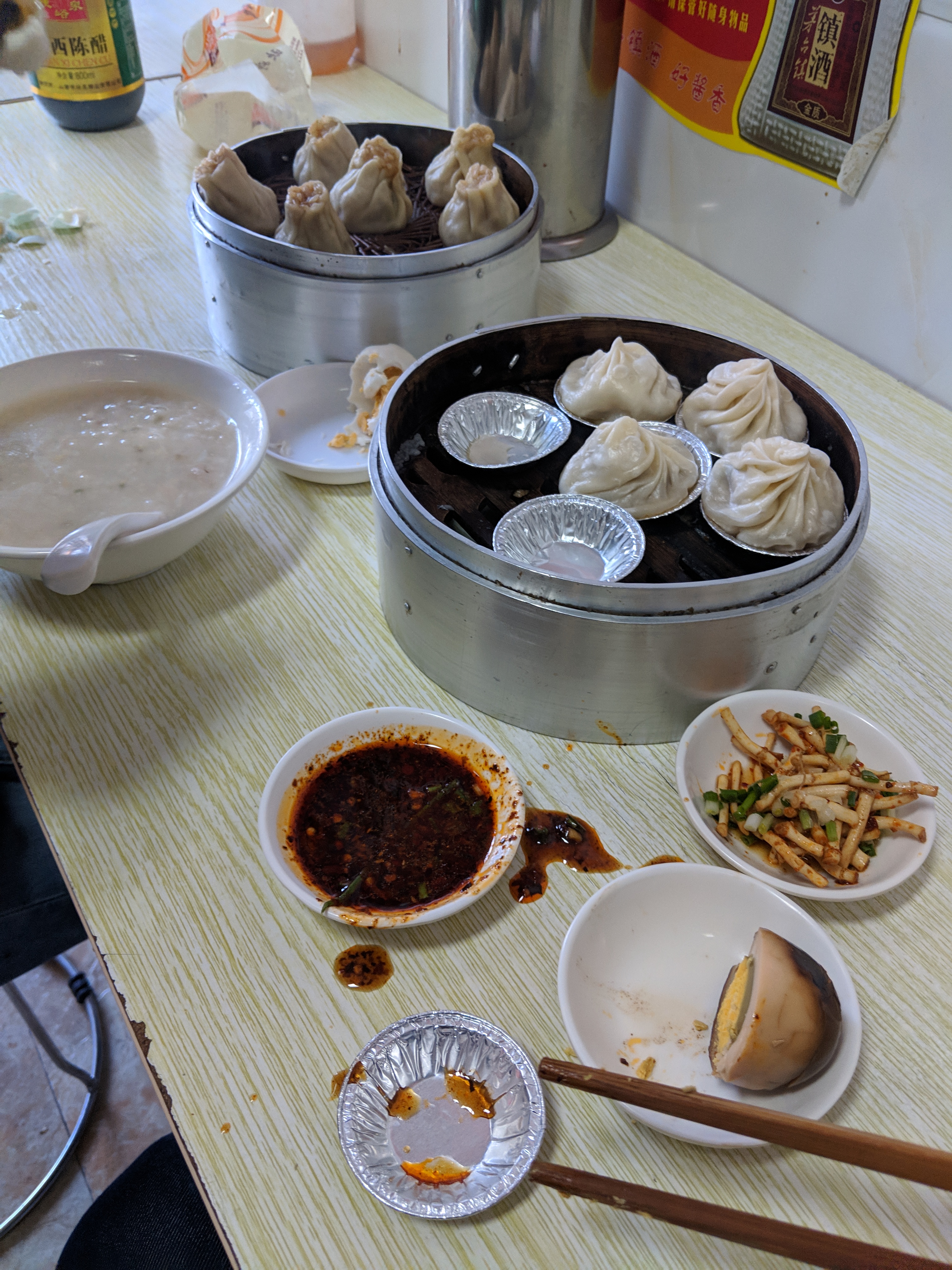Tianjin soup dumplings
For quite a while after I first came to China, I was scared to go to new restaurants alone and order in Chinese. I walked everywhere, and we live on a pretty huge hill, so I would occasionally get hungry enough to overcome my fear of interaction using another language. (I lost about 10 pounds during this period. Unfortunately, as my Chinese got better, my weight went back up.)
This post is about the menu at Tianjin Soup Dumplings, a tiny restaurant near my elementary school. My interactions with the owner were, at first, limited to something like:
”你好,可以买一笼包子和一个鸡蛋?” (Hello, can I buy a basket of buns and an egg?)
“九块。” (9 yuan.)
“谢谢。” (Thanks.)
“不用谢。” (No need for thanks.)

一笼包子
Anyways, to improve my vocabulary, I like to translate menus.
Here’s a photo of the menu (notice the green WeChat Pay and blue AliPay QR codes):

天津灌汤菜单
Here’s my translation:
| 天津灌汤包价目表 | |
|---|---|
| Tiānjīn guàn tāng bāo jiàmù biǎo (Tianjin soup-filled dumplings price list) | |
| 生煎包 | 10元10个 |
| shēng jiān bāo (pan-fried buns) | 10 yuán 10 gè (10 for ¥10) |
| 锅铁饺 | 10元10个 |
| guō tiě jiǎo (pan-fried dumplings) | 10 yuán 10 gè (10 for ¥10) |
| 鸡汁灌汤包 | 8元/笼 |
| jī zhī guàn tāng bāo (chicken juice soup-filled dumplings) | 8 yuán/lóng (¥8/basket) |
| 鲜肉包 | 7元/笼 |
| xiān ròu bāo (fresh meat buns) | 7 yuán/lóng (¥7/basket) |
| 香菇包 | 7元/笼 |
| xiānggū bāo (fragrant mushroom buns) | 7 yuán/lóng (¥7/basket) |
| 豆沙包 | 7元/笼 |
| dòushā bāo (red bean paste buns) | 7 yuán/lóng (¥7/basket) |
| 肉丁烧麦 | 7元/笼 |
| ròu dīng shāomài (sliced meat rice dumplings) | 7 yuán/lóng (¥7/basket) |
| 鲜肉蒸饺 | 7元/笼 |
| xiān ròu zhēng jiǎo (fresh meat steamed dumplings) | 7 yuán/lóng (¥7/basket) |
| 韭菜鸡蛋蒸饺 | 7元/笼 |
| jiǔcài jīdàn zhēng jiǎo (chive and chicken egg steamed dumplings) | 7 yuán/lóng (¥7/basket) |
| 皮蛋瘦肉粥 | 5元/碗 |
| pídàn shòu ròu zhōu (century egg and lean meat congee) | 5 yuán/wǎn (¥5/bowl) |
| 黑米粥 | 3元/碗 |
| hēi mǐ zhōu (black rice congee) | 3 yuán/wǎn (¥3/bowl) |
| 南瓜粥 | 3元/碗 |
| nánguā zhōu (pumpkin congee) | 3 yuán/wǎn (¥3/bowl) |
| 绿豆粥 | 3元/碗 |
| lǜdòu zhōu (mung bean congee) | 3 yuán/wǎn (¥3/bowl) |
| 大米稀饭 | 2元/碗 |
| dàmǐ xīfan (rice congee) | 2 yuán/wǎn (¥2/bowl) |
| 九阳豆浆 | 3元/杯 |
| jiǔ yáng dòujiāng (nine sun soy milk) | 3 yuán/bēi (¥3/cup) |
| 咸鸭蛋 | 2元/个 |
| xián yādàn (salty duck eggs) | 2 yuán/gè (¥2 each) |
| 五香茶叶蛋 | 2元/个 |
| wǔxiāng cháyè dàn (five-spice tea leaf eggs) | 2 yuán/gè (¥2 each) |
| 煮水饺 | 10元/碗 |
| zhǔ shuǐjiǎo (boiled dumplings) | 10 yuán/wǎn (¥10/bowl) |
| 煮馄饨 | 7元/碗 |
| zhǔ húntún (boiled wontons) | 7 yuán/wǎn (¥7/bowl) |
Translation notes
Prices
They’re cheap. Any one of those ¥7 ($1) baskets will fill you up. Notice there are 4 different measure words for the prices: 个 (gè, each), 笼 (lóng, basket), 碗 (wǎn, bowl), and 杯 (bēi, cup).
Pan-fried
-
生煎包 shēng jiān bāo
-
锅铁饺 guō tiě jiǎo
I’m not sure why one of these is 锅铁 and one is 生煎, but they’re pretty straightforward. They’re both pan-fried versions of either 饺子 (jiǎozi, dumplings) or 包子 (bāozi, buns).
Steamer baskets
-
鸡汁灌汤包 jī zhī guàn tāng bāo
Chicken juice is the literal translation of 鸡汁. Maybe chicken broth would be more accurate. But really, who needs two words for juice and broth. Maybe English should just settle on one.
-
鲜肉包 xiān ròu bāo
Fresh pork meat buns. Notice that pork isn’t actually specified here, just 肉 or meat. But you can probably assume it’s pork when that happens. This is what I was ordering when I only knew how to order one thing. They’re delicious - full-size baozi usually have too much steamed bread for me.
-
香菇包 xiānggū bāo
Same as above, but filled with “fragrant mushrooms.” Haven’t tried these yet.
-
豆沙包 dòushā bāo
Red bean buns, lightly sweetened. I don’t think I’ve ordered them here, but if you know what you’re getting in to they’re pretty good. If you’re expecting something savory, then you will be unhappy.
-
肉丁烧麦 ròu dīng shāomài
These shaomai are dumpling skin, wrapped around pork-fried rice, with the top part open. I’ve had them a few times here. They’re good, but a lot of carbs if that’s all you’re eating. They’re in the back of the image below.

粥, 鸡蛋,包子
From left to right: congee (稀饭), a salty duck egg, soup buns, and a tea egg. Those little white roots are 折耳根 (zhé ěrgēn, fish mint roots), a Guiyang specialty. Also pictured: I am a horribly messy eater.
-
鲜肉蒸饺 xiān ròu zhēng jiǎo
-
韭菜鸡蛋蒸饺 jiǔcài jīdàn zhēng jiǎo
These are fresh meat steamed dumplings and chive and chicken egg steamed dumplings. I haven’t tried either here yet.
Congee
-
皮蛋瘦肉粥 pídàn shòu ròu zhōu
Century egg and lean meat congee. Century eggs are those translucent black and green preserved duck eggs. Definitely an acquired taste. One which I have acquired.
-
黑米粥 hēi mǐ zhōu
-
南瓜粥 nánguā zhōu
-
绿豆粥 lǜdòu zhōu
Black rice, pumpkin, and mung bean congee.
-
大米稀饭 dàmǐ xīfan
This is plain congee. I’m not sure exactly what the difference between 粥 and 稀饭 is. It depends on who I ask. Maybe 稀饭 is thinner, or maybe 粥 is a more general term (so it can be other grains besides rice), or both.
Sides
-
九阳豆浆 jiǔ yáng dòujiāng
Hot, sweetened soy milk.
-
咸鸭蛋 xián yādàn (salty duck eggs)
They aren’t kidding about the salty part. These are great, but you have to break them up and eat a little bit at a time, maybe mixed with congee. Pictured above.
-
五香茶叶蛋 wǔxiāng cháyè dàn
AKA tea eggs. Sometimes I see these listed as 卤鸡蛋 (lǔ jīdàn, braised eggs). Half of one pictured above.
Boiled
-
煮水饺 zhǔ shuǐjiǎo
-
煮馄饨 zhǔ húntún
Boiled dumplings or wontons, served in a bowl with the water they were boiled in.